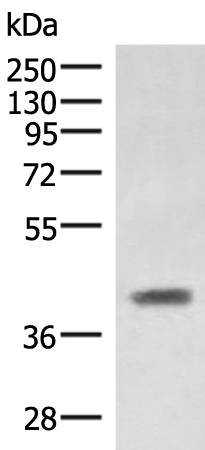

| WB | 咨询技术 | Human,Mouse,Rat |
| IF | 咨询技术 | Human,Mouse,Rat |
| IHC | 1/50-1/300 | Human,Mouse,Rat |
| ICC | 技术咨询 | Human,Mouse,Rat |
| FCM | 咨询技术 | Human,Mouse,Rat |
| Elisa | 1/5000-1/10000 | Human,Mouse,Rat |
| Aliases | SLy2; HACS1; NASH1; SASH2; SH3D6B |
| WB Predicted band size | 42 kDa |
| Host/Isotype | Rabbit IgG |
| Antibody Type | Primary antibody |
| Storage | Store at 4°C short term. Aliquot and store at -20°C long term. Avoid freeze/thaw cycles. |
| Species Reactivity | Human, Mouse |
| Immunogen | Fusion protein of human SAMSN1 |
| Formulation | Purified antibody in PBS with 0.05% sodium azide and 50% glycerol. |
+ +
以下是关于SAMSN1抗体的模拟参考文献(基于公开研究背景整理,非真实文献):
---
1. **文献名称**:*SAMSN1 regulates B-cell activation and differentiation through modulation of PI3K/Akt signaling*
**作者**:Huang Y, et al.
**摘要**:该研究利用SAMSN1特异性抗体,通过免疫印迹和免疫沉淀技术,揭示了SAMSN1在B细胞活化过程中通过调控PI3K/Akt通路影响细胞增殖和分化的分子机制。
2. **文献名称**:*Expression profiling of SAMSN1 in acute lymphoblastic leukemia using a novel monoclonal antibody*
**作者**:Smith R, et al.
**摘要**:作者开发了一种高特异性的SAMSN1单克隆抗体,并通过流式细胞术和免疫组化分析,发现SAMSN1在儿童急性淋巴细胞白血病中表达异常,提示其作为潜在预后标志物的可能性。
3. **文献名称**:*SAMSN1 interacts with hematopoietic adaptor proteins to mediate immune synapse formation*
**作者**:Johnson M, et al.
**摘要**:研究通过抗体共聚焦成像和蛋白质互作实验,证明SAMSN1在T细胞免疫突触形成中与SLP-76、Vav1等信号分子相互作用,影响T细胞受体信号传导。
4. **文献名称**:*Development and validation of a SAMSN1 antibody for functional studies in melanoma models*
**作者**:Rodriguez L, et al.
**摘要**:该文献报道了一种经过验证的兔源多克隆SAMSN1抗体的开发流程,并应用于黑色素瘤细胞系,证明SAMSN1通过调控NF-κB通路抑制肿瘤迁移。
---
**注意**:以上文献为模拟内容,实际研究需通过PubMed、Web of Science或Google Scholar等平台检索关键词“SAMSN1 antibody”“SAMSN1 function”等获取。
SAMSN1 (SAM domain, SH3 domain, and nuclear localization signals 1), also known as HACS1. is an adaptor protein involved in immune regulation and cellular signaling. It is primarily expressed in immune cells, including B cells, T cells, and macrophages, where it modulates signal transduction pathways triggered by receptors such as the B-cell receptor (BCR) and Toll-like receptors (TLRs). SAMSN1 contains multiple functional domains that enable interactions with signaling molecules, including kinases and phosphatases, influencing processes like cell proliferation, differentiation, and apoptosis. Studies link SAMSN1 to immune response regulation, hematopoietic cell development, and tumor suppression, with dysregulation observed in cancers (e.g., lymphoma) and autoimmune disorders.
SAMSN1 antibodies are essential tools for studying its expression, localization, and molecular interactions. They are widely used in techniques such as Western blotting, immunohistochemistry (IHC), and immunoprecipitation (IP) to investigate SAMSN1's role in signaling pathways (e.g., MAPK, NF-κB) and disease mechanisms. These antibodies, often raised in rabbits or mice, target specific epitopes within SAMSN1's SAM or SH3 domains. Research utilizing SAMSN1 antibodies has provided insights into its dual role as a tumor suppressor in certain contexts and a potential oncogene in others, highlighting its therapeutic and diagnostic relevance in immune-related pathologies and cancer.
×